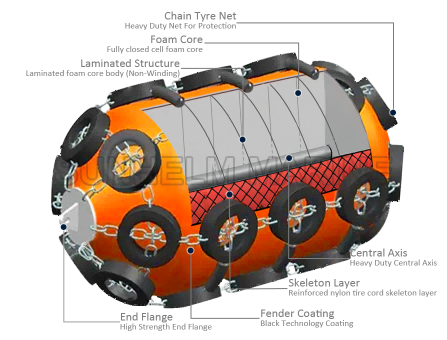When you pick fenders, you buy protection. Foam-filled floating fenders (often called foam fenders) give a simple, robust way to protect ships and docks. This short guide explains what they are, why many ports choose them, how to pick the right type, and how to buy with confidence. I keep the language simple and practical so you can act on it fast.
What they are — in plain words
A foam-filled fender has a solid foam core wrapped in a tough rubber or elastomer skin. The foam keeps the fender floating and holds shape even if the outer skin gets damaged. Unlike air-filled fenders, these do not rely on pressure to work.
Why many shipowners and designers like them
- They don’t deflate. You avoid sudden loss of protection from a puncture. This lowers downtime and risk at the berth.
- Good energy absorption with low rebound. Foam fenders soak up collision energy inside their core. Ships tend to settle against the berth instead of bouncing back, which lowers shock on hulls and quay structures.
- Rugged outer skin. The skin resists UV, salt, oil and common fuels. That means longer life and lower upkeep compared with some alternatives.
- Simple to handle and install. Most units come with built-in lugs or chain-through fixtures; you don’t need complex inflation equipment.
Common types and where they work best
Manufacturers make foam fenders in many shapes and sizes: cylindrical, donut (monopile) types, netted or netless ocean-guard styles, and special submarine or pile fenders. Use smaller, lighter foam fenders for small craft or service berths. Use larger, long-length foam fenders where ships berth at speed or where you need more energy capacity. Product catalogs list energy-absorption and reaction-force figures you can use in fender design checks.
How to choose the right fender
Focus on a few numbers and conditions, not brand names:
- Energy absorption (EA): Make sure the fender’s EA at a standard compression (often 60%) meets the required energy from the ship’s berthing scenario. Manufacturer tables give EA values for different sizes.
- Reaction force: Lower reaction force is better for smaller or delicate quays and for fast berthing. Foam fenders generally have lower reaction forces than hard rubber alternatives.
- Fender spacing and number: A few large fenders often perform better than many small ones. Check spacing guidance in supplier catalogs.
- Operating environment: If the berth sees hydrocarbons, ice, or strong UV, pick a skin material and reinforcement rated for those hazards.
Installation, maintenance and lifespan
Install them with proper chains, shackles and back-up plates. Regular inspections should look for skin cuts, abrasion or lost lugs. Because the core is solid foam, you won’t have to monitor pressure and you can expect lower day-to-day maintenance vs pneumatic fenders. Still, schedule checks and replace skins or fittings when they show heavy wear.
Buying tips — get value, not just a low price
- Ask manufacturers for EA and reaction force tables for the exact size you plan to buy. Compare those numbers, not only dimensions.
- Check whether the supplier offers OEM or custom sizes and their lead times. Many reputable makers customize length, diameter and skin material.
- Request references or case studies for similar berths (same ship sizes, same wave/current exposure). Good suppliers will show installations.
- Confirm delivery terms, warranty and spare-part availability. A slightly higher cost with a reliable warranty often saves money in the long run.
Quick ROI case (simple logic)
A correctly sized foam fender reduces hull strikes, paint damage, and quay repairs. Those savings add up fast compared with the one-time cost of a quality foam fender system. In many ports, better fenders cut repair invoices and vessel delays — and protect your reputation for safe berthing.
ЧАСТО ЗАДАВАЕМЫЕ ВОПРОСЫ
Q: Do foam fenders work for heavy ships?
A: Yes — but choose larger diameter and longer fenders with higher EA and check the reaction-force numbers.
Q: Can I use foam fenders in cold or oily waters?
A: Yes, pick a skin material rated for low temperature and hydrocarbon resistance. Ask the maker for test data.
Q: Do they need lots of maintenance?
A: No. They need routine inspections and occasional skin or fitting replacement, but no pressure checks.


